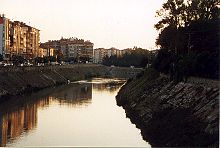Battle of the Iron Bridge
| Battle of the Iron Bridge | |||||||
|---|---|---|---|---|---|---|---|
| Part of the Arab–Byzantine Wars and Campaigns of Khalid ibn al-Walid | |||||||
 The Orontes River at its passage in Antioch; the battle was fought near this river | |||||||
| |||||||
| Belligerents | |||||||
| Rashidun Caliphate |
Arabs | ||||||
| Commanders and leaders | |||||||
|
Abu Ubaidah ibn al-Jarrah | Unknown | ||||||
| Strength | |||||||
| 17,000[1] | 15,000–20,000[1] | ||||||
| Casualties and losses | |||||||
| Unknown | Unknown | ||||||
The Battle of the Iron Bridge was fought between the Muslim Rashidun army and the Byzantine army in 637 AD. The battle took its name from a nearby nine-arch stone bridge (also known as Jisr al-Hadid) spanning the Orontes River which had gates trimmed with iron.[1] It was one of the last battles fought between the Byzantines and Rashidun Caliphate in the province of Syria. The aftermath of the battle marked the nearly complete annexation of the province into the Rashidun Caliphate with the fall of its capital, Antioch.
Background
The Rashidun army had achieved a decisive victory at the
The battle
Twenty kilometers (12 mi) from the city, near modern-day Mahruba, a bridge of iron spanned the River
Aftermath
Following the surrender of Antioch, Rashidun army columns moved south along the
References
- ^ a b c "Byzantine Battles: Battle of Iron Bridge".
- ISBN 0-7101-0104-X.
- al-Tabari, Muhammad ibn Jarir. History of the Prophets and Kings, Vol. 3, p. 98.
- ^ a b Crawford, Peter (16 July 2013). The War of the Three Gods: Romans, Persians and the Rise of Islam. Pen and Sword.
- al-Tabari, Muhammad Ibn Jarir. History of the Prophets and Kings, Vol. 3, pp. 99–100.
- ^ ISBN 978-1-317-54041-0. Retrieved 30 January 2024.
- ISBN 0-7101-0104-X.
